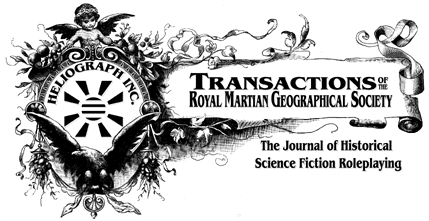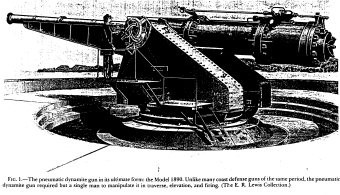
Buy | Submit | TRMGS1 | TRMGS2 | TRMGS3 | TRMGS4 |TRMGS Main | Heliograph Main
|
WHAT'S NEW?
The Complete Canal Priests Of Mars is now available!
The original publication of Canal Priests Of Mars cut slightly over a third of author Marcus L. Rowland's manuscript to fit GDW's adventure format.
The Complete Canal Priests Of Mars restores the cut material, features all new artwork by Paul Daly, and adds many useful player handouts. Enjoy the "author's cut" of a classic Space 1889 adventure, or experience it for the first time!
See our Buy It! page for more information!
Old news is still available on the News Page.
|
The Zalinski Dynamite Gun
by Mark Clark
The Zalinski dynamite gun was an offbeat yet innovative weapon
developed and used by the American military around the turn of the
century. Designed by Edmund Zalinski, an American artillery officer, the gun
used compressed air to hurl a large dynamite charge several miles. Although
a technical success, the gun was never popular with the American
military establishment and only a few were ever built. This article discusses
Zalinski, his work with the dynamite gun, and its operational employment. It
then goes on to discuss how the gun could be used in a roleplaying environment.
Edmund Zalinski
Edmund Louis Grey Zalinski was born in Poland, but served in the
American military as an artillery officer during the Civil War. He remained in
the army after the war, and in 1883 was serving as a lieutenant at Fort
Hamilton, one of the installations that guarded the port of New York. An Ohio
schoolteacher by the name of Mefford had invented a pneumatic gun, and
brought it to Fort Hamilton for trials. Mefford's device was little more than a toy,
and he returned to Ohio without a government contract. However, Mefford's
demonstration aroused Zalinski's interest, and over the next two years
Zalinski built a series of increasingly larger models, improving on Mefford's
design. In 1885, he demonstrated an operational prototype with an 8-inch bore
that could fire a 100 pound charge of dynamite two miles. The gun was
more accurate than contemporary cannon and carried a larger explosive
charge, though the range was inferior.
Zalinski demonstrated this prototype to a large number of visitors,
and by 1886 he had interested a number of naval officers in the possibilities
of the weapon. The Department of the Navy decided to fund the
construction of a "dynamite cruiser", and investors set up the Pneumatic
Dynamite Gun Company in New York to manufacture guns to Zalinski's design. In 1887,
the navy arranged a test in which the dynamite gun fired a shell that
completely destroyed a target ship. The subsequent publicity led to the completion
of the dynamite cruiser Vesuvius. In 1889, recently promoted to captain,
Zalinski was assigned as the military attache in St. Petersburg, Russia. He
returned the following year, and was assigned to supervise the construction of
several dynamite guns then being built by the Pneumatic
Dynamite Gun Company for coastal defense purposes. Zalinski was forced to resign due to
ill health in 1894. After a lingering illness, he died in 1909.
The Dynamite Gun

The final version of the dynamite gun, a 15-inch bore monster,
was produced in two versions, one for use aboard the
Vesuvius and the other for four coastal defense installations in the United States. The naval
version was thoroughly tested, and though capable of firing a quarter-ton
dynamite charge over four miles, the gun was difficult to aim and experienced
constant mechanical problems. The Vesuvius never reached active service,
and the navy deferred further experiments until the army could perfect
the weapon.
The Army began to experiment with Zalinski's gun later than the
Navy due to the opposition of the Board of Ordnance and Fortification, the
army department in charge of developing new weapons. Officers on the
board favored continued experiments with conventional cannon rather than
funding Zalinski's work. Publicity from Zalinski's tests and the work being
done on the Vesuvius eventually forced the Board to approve construction of
a test battery of dynamite guns. The battery was installed at Fort Hancock
in New Jersey in 1894. It contained two 15-inch guns, as well as the
8-inch prototype. Tests proved very satisfactory, and the Army ordered a
second battery of three 15-inch guns, which were installed at San Francisco to
guard the Golden Gate in 1898. Two more batteries of one gun each were built
at Hilton Head, South Carolina and Fishers Island, New York in 1901. In
1904, all four batteries were sold for scrap, and the company that built them
went out of business.
Why was Zalinski's gun not more successful? The initial enthusiasm
for the weapon was due to its ability to throw a very large explosive charge
a great distance. Dynamite, which is much more destructive than
gunpowder, cannot be fired by conventional cannon, as the heat and shock of the
launch would make the dynamite explode in the gun's barrel. Thus, Zalinski's
gun was very attractive to naval and coastal defense officers who wanted a
weapon to deal with the new steel-armored warships of the period. Zalinski's
gun could sink such ships by throwing large dynamite charges next to the
ships. The resulting shock waves transmitted by the water would buckle the
ship's sides and sink it.
Unfortunately for Zalinski and his gun, this task could be achieved
more easily by fixed mines, or torpedoes as they were called in the 19th
century. Mines could be tethered to the bottom of a harbor's channel and
exploded by wire from shore. Dating from the American Civil War, mines were a
well developed technology by the 1880's. Zalinski was only able to sell his
gun as suitable for unusual harbors, where strong currents or deep
channels made mines unsuitable. The Golden Gate in San Francisco is an
obvious example of such a shipping channel.
What finally made the dynamite gun obsolete was the development
of new high explosives, such as ammonium picrate, in the late 1890's.
These new explosives could be fired from conventional cannon, and in
combination with armor-piercing shells were an effective weapon versus
armored warships. A dynamite gun was as expensive to construct as a 10 or
12-inch shore defense battery, but had a shorter range and was more expensive
and complex to maintain. Moreover, the increasing range of ship-mounted
weapons meant that an invading navy's guns would out range the
dynamite gun and so could destroy it from a distance with impunity. As a result,
dynamite guns were no longer useful and so were scrapped.
The Dynamite Gun and Roleplaying
Although Zalinski's weapon was never fired in anger, there is no
reason why it could not be used as the focus of an adventure. Several scenarios
are possible for a Wild West campaign. First, some foreign agent might
attempt to steal the plans of the gun or kidnap Zalinski. This would make the
most sense if set in the late 1880's. Second, the players might encounter
the Vesuvius or some other vessel armed with a
dynamite gun. For example, in the late 1880s the Brazilians bought a
dynamite gun that was hastily mounted on the deck of a freighter for an attack on a group of rebels. Although
no other foreign government actually bought a dynamite gun, Italy and
Britain ordered coastal defense versions of the weapon (they later canceled
the orders) and Austria, Denmark, France and Spain all indicated interest in
a purchase. Finally, the players might get wind of a plot to sabotage the
San Francisco dynamite gun battery to allow the entrance of a hostile fleet
(Chinese, Japanese or Russian) for an invasion of California.
The dynamite gun would also fit in a Space:
1889 campaign very easily. In addition to the ideas given above, a player character inventor might
want to develop an improved dynamite gun for use on a cloudship, or a
villain might be using for his own nefarious purposes. The American military
might also install a dynamite gun on one of its aerial flyers on Mars. In
Sky Galleons of Mars terms, a 15-inch dynamite gun would have a range of about
8, damage value of 8, a penetration of 1 (the shell casing is very light), a
crew of 4 (including one engineer), and a rate of fire of (1). Note that a
dynamite gun requires a steam power plant to provide the compressed air it uses.
Note: Thomas Gray contributed ideas about using the
dynamite gun in Space: 1889 to this article. For more information on Zalinski and his gun, see
David M. Hansen, "Zalinski's Dynamite Gun,"
Technology & Culture, Volume 25, number 2, April 1984, pp. 264-279.
Posted Monday, 04-May-2009 19:48:58 EDT
Return to Main Page
Comments to webmaster@heliograph.com
The material on this page is Copyright 2000 under the author or artist's name unless noted otherwise, and cannot be used without permission. This presentation Copyright 2000 by Heliograph, Inc. Space:1889 is a registered trademark of Frank Chadwick, all rights reserved, and is used with his permission. Most other game, movie, or book names may be trademarks of their respective holders, and use of a trademark at this site should not be construed as implying the sponsorship of the trademark holder, nor, conversely, should use of the name of any product without mention of trademark status be construed as a challenge to such status. Heck no! We love those guys.
